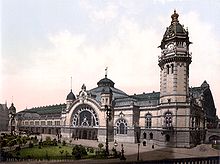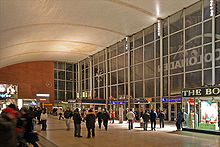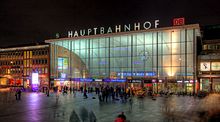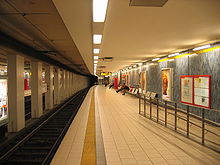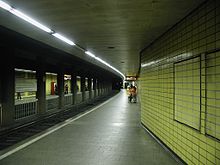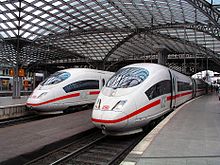- Köln Hauptbahnhof
-

Köln Hauptbahnhof 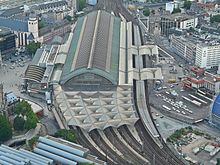
Aerial view of the station in 2010 Operations Category 1 Type Hbf Platforms in use 11 Daily trains 1230[1] Daily entry/exit 280,000[1] DS100 code KK Construction and location Opened 1859, 1894, 1957 Location Cologne State North Rhine-Westphalia Country Germany Local authority Innenstadt Home page www.bahnhof.de 50°56′33″N 6°57′29″E / 50.9425°N 6.95806°E Route information - Cologne–Frankfurt HSL
- Cologne–Krefeld S 11
- Cologne–Aachen S 12
- West Rhine line
- Cologne–Duisburg S 6
- Cologne–Sieg S 12
- Cologne–Wuppertal
List of railway stations in North Rhine-Westphalia Köln Hauptbahnhof (English: Cologne Central Station, abbr.: Köln Hbf) is the central railway station in Cologne, Germany.
The station is an important local, national and international hub, with many ICE, Thalys and Intercity trains calling there, as well as regional RegionalExpress, RegionalBahn and local S-Bahn trains. EuroNight and DB NachtZug night services also call at the station. It has frequent connections to Frankfurt by way of the Cologne-Frankfurt high-speed rail line, which starts in southern Cologne. On an average day, about 280,000 travellers frequent the station, making it fifth busiest station in Germany.
The station is situated next to Cologne cathedral.
There is another important train station in Cologne, the Köln Messe/Deutz railway station across the river Rhine, just about 400 metres away from Köln Hauptbahnhof. The stations are linked by the Hohenzollernbrücke, a six-track railway bridge with passenger walkways on each side. Frequent local services connect the two stations as well.
Contents
History
By 1850 there were five different stations at Cologne railway companies. On the west bank of the Rhine there were the Bonn-Cologne Railway Company (German, old spelling: Bonn-Cölner Eisenbahn-Gesellschaft, BCE), the Cologne-Krefeld Railway Company (German, old spelling: Cöln-Crefelder Eisenbahn-Gesellschaft, CCE) and the Rhenish Railway Company (German: Rheinische Eisenbahn-Gesellschaft, RhE). On the east bank there were the Bergisch-Märkische Railway Company (German: Bergisch-Märkische Eisenbahn-Gesellschaft, BME) and the Cologne-Minden Railway Company (German, old spelling: Cöln-Mindener Eisenbahn-Gesellschaft, CME). In 1854 a controversial decision was taken to locate a new rail and road bridge next to the cathedral, as a bridge could be connected to the existing freight and temporary passenger station on the banks of the Rhine (Rhine Station at the street of Trankgasse). The city agreed to the proposal in 1857 and made available the ground of the former Botanical garden to the north of the cathedral and on the site of part of the old University of Cologne, suppressed by the French in 1798. The railway track was laid at ground level from the bridge over the Rhine and crossing the street of Eigelstein west of the station at ground level and running through the medieval city wall.
Original station
The original Central Station (German: Centralbahnhof) was built beginning in 1857 to the plans of Hermann Otto Pflaume on behalf of the RhE, which had in the same year acquired the BCE. The station was opened on 5. December 1859 together with the Cathedral Bridge (German: Dombrücke, later the site of the Hohenzollernbrücke). The Central Station was a combined terminal and through station: it included four terminal tracks for the RhE running to the west, while the CME had two through tracks connected to its line on the eastern side of the Rhine by the Cathedral Bridge.
The central station quickly reached capacity, but the RhE as operator had only limited interest in developing the station, as this would have mainly benefited competing companies. Serious planning for an enlarged station was therefore only taken after the nationalisation of the railways in the 1880s.
New station
For the planning of the new central station two options were considered:
- Construction of a major railway station in an open area north of Venloer Straße and reclassifying of the original station as a minor station, or
- Replacement of the central station with a new building at the same place with an increase in platforms and the construction of two secondary passenger stations (Cologne West and Cologne South) on the urban railway on the model of Berlin Stadtbahn and a rail freight bypass.
While the German government argued for the second option, opinion in Cologne was split. On 9 January 1883, the Cologne City Council decided by one vote, finally, for the second option under a plan by the engineer E. Grüttefien of Berlin. Construction began in 1889. The tracks were raised by six metres with half the new space created under the track filled with earth and a new entrance building was built to the design of Georg Frentzen, an architect from Aachen.
In 1894, the large tripartite platform hall was completed. The central hall had a roof span of 64 metres covering today's platforms 2 to 7 and outside it were two 13.5 metre-wide aisles, for platforms 1 and 8. The 255 metre-long hall included a two-story waiting room building, with easy access to all platforms. The station included four terminating platforms facing east and four facing west on either side of the waiting rooms and one through platform on the northeast side and one on the southwest side.
During the restructuring of the all the rail tracks in the Cologne area (about 1905-1911), most notable for the construction of the new South Bridge and the four-track Hohenzollern Bridge, the waiting room building was removed and all the platforms were rebuilt as through platforms. Advantage was taken of the previously unused space beneath the tracks. Only the first and second class waiting rooms in Trankgasse and Johannisstraße (streets) survived the World War II and subsequent modifications and are now used as a restaurant and the Alter Wartesaal events centre.
Reconstruction and new construction
For several years after World War II, there was debate as to whether the main station should be rebuilt on the site of the Gereon freight yard—now the site of MediaPark. Therefore, the reconstruction of the main railway station was a slow process and for a decade Cologne station included temporary structures.
The first building occurred in 1953 with the demolition of the long building on the western side, which was replaced by a modern building with baggage handling facilities and a hotel. The old station building (which had been only slightly damaged during the war and temporarily repaired) was demolished in 1955. On 23 September 1957, the new station hall with its shell-shaped roof was opened to the design of the architects Schmitt and Schneider. The main station building was built on the northern side of the station following the demolition of an originally built-up area between the streets of Maximinenstraße, Domstraße, Hofergasse and Hermannstraße and the shifting of Goldgasse with the building of Breslauer Platz as a second entrance plaza.
In the course of building the S-Bahn up until 1991, the entire railway line, railway station and the Hohenzollern bridge were supplemented by two independent S-Bahn tracks. First, in 1975 two additional platforms were built (10 and 11) and then the additional tracks were built on the Hohenzollern bridge for the S-Bahn line.
In 2000, a shopping centre was opened at the entry level—including the area under the S-Bahn tracks. The so-called colonnade includes 70 shops and restaurants with over 11,500 square metres of retail space and 700 employees.
Operational usage
The station has to cope with a very high daily load; even though some ICE services now call at the Köln-Deutz station, though its platforms are divided into three sections each, are still remarkably crowded all over the day, and a major extension of the station is impossible because of its unique surroundings. Connections to the local Cologne network Stadtbahn are made by two subterranean stations, Dom/Hbf and Breslauer Platz/Hbf at the respective ends of the station. The station has 11 main line passenger track platforms, of which two are used for S-Bahn services; the two subterranean Stadtbahn stations have two tracks each. Its IATA code is QKL.
The station's building also hosts a large shopping mall, the Colonaden.
Long distance trains
Preceding station Thalys Following station toward Paris-NordThalys toward Essen HbfPreceding station DB AG Following station TerminusICE 10 toward Berlin Ostbahnhoftoward Trier Hbftoward München HbfICE 31 train route splits here and rejoins in Dortmund Hbftoward Kiel HbfWuppertal Hbftoward Kiel Hbftoward München HbfICE 42 reverses outtoward Hamburg-Altonatoward Basel SBBICE 43 reverses outtoward Amsterdam CentraalSolingen Hbftoward Hannover HbfTerminus ICE 45 Köln/Bonn Flughafentoward Stuttgart HbfTerminus ICE 49 toward Frankfurt (Main) HbfFrankfurt Flughafentoward Frankfurt (Main) HbfICE 78 reverses outtoward Amsterdam Centraaltoward Bruxelles-MidiICE 79 Frankfurt Flughafentoward Frankfurt (Main) Hbftoward Wien WestbfICE 91 train route rejoins heretoward Dortmund HbfSolingen Hbftoward Dortmund HbfTerminus IC 26 Köln-Hamburgtoward Hamburg-Altonatoward Stuttgart HbfIC/EC 30 toward Ostseebad Binz or Greifswaldtoward Passau HbfIC/EC 31 Solingen Hbftoward Hamburg-Altona/Kiel Hbf/Puttgardentoward Innsbruck HbfIC/EC 32 toward Berlin SüdkreuzIC/EC 35 toward Emden Außenhafen or Norddeich MoleTerminus IC 51 toward Ostseebad Binztoward Köln HbfIC 55 train route splits here and rejoins in Dortmund Hbftoward Leipzig HbfSolingen Hbftoward Leipzig HbfRegional trains
Preceding station DB AG Following station Köln-Ehrenfeldtoward Aachen HbfRE 1
NRW-ExpressKöln Messe/Deutztoward Paderborn HbfKöln Südtoward Koblenz HbfRE 5
Rhein-ExpressKöln Messe/Deutztoward Emmerichtoward Krefeld HbfRE 7
Rhein-Münsterland-ExpressKöln Messe/Deutztoward RheineKöln-Ehrenfeldtoward Mönchengladbach HbfRE 8
Rhein-Erft-ExpressKöln Messe/Deutztoward Koblenz HbfKöln-Ehrenfeldtoward Aachen HbfRE 9
Rhein-Sieg-ExpressKöln Messe/Deutztoward SiegenKöln-Westtoward Trier HbfRE 12
Eifel-Mosel-ExpressKöln Messe/DeutzTerminusKöln-Westtoward GerolsteinRE 22
Eifel-ExpressKöln-Westtoward KallRB 24
Eifel-BahnKöln Messe/DeutzTerminusKöln HansaringTerminusRB 25
Oberbergische BahnKöln Messe/Deutztoward MarienheideKöln-Ehrenfeldtoward Mönchengladbach HbfRB 27
Rhein-Erft-BahnKöln Messe/Deutztoward Koblenz HbfKöln-Ehrenfeldtoward Düsseldorf HbfRB 38
Erft-BahnTerminus Köln-Westtoward Bonn-MehlemRB 48
Rhein-Wupper-BahnKöln Messe/Deutztoward Wuppertal HbfPreceding station trans regio Following station Köln-Westtoward Koblenz HbfMRB 26
MittelrheinBahnKöln Messe/DeutzTerminusS-Bahn trains
Several Rhine-Ruhr S-Bahn lines call at the station:
- S 6 Köln-Nippes — Köln Hbf — Langenfeld — Düsseldorf Hbf — Ratingen Ost — Essen Hbf
- S 11 (Wuppertal-Vohwinkel —) Düsseldorf — Neuss — Dormagen — Köln Hbf — Bergisch Gladbach
- S 12 Düren — Horrem — Köln Hbf — Troisdorf — Siegburg/Bonn — Hennef — Au
- S 13 (Horrem —) Köln Hbf — Cologne/Bonn Airport — Troisdorf
Preceding station Rhine-Ruhr S-Bahn Following station Köln Hansaringtoward Köln-NippesS6 Köln Messe/Deutztoward Essen HbfKöln Hansaringtoward Düsseldorf Flughafen TerminalS11 Köln Messe/Deutztoward Bergisch GladbachKöln Hansaringtoward DürenS12 Köln Messe/Deutztoward Au (Sieg)Köln Hansaringtoward Köln Hansaring or HorremS13 Köln Messe/Deutztoward TroisdorfLocal services
Connection to local Stadtbahn lines is provided by the underground stations Dom/Hbf and Breslauer Platz/Hbf. The former one is located below the southern end, next to the cathedral, the latter at the northern end where it connects to the bus station. Currently, Breslauer Platz/Hbf is closed because it is being rebuilt to link the new North-south line with the existing network. Reopening is scheduled for December 2011. Formerly, all trains stopped at Dom/Hbf and Breslauer Platz/Hbf, but, as the junction for the new line will be between these stations, line 5 trains will only stop at Dom/Hbf and line 16 trains only at Breslauer Platz/Hbf when the line is opened.
Services are offered by the Cologne Stadtbahn and the Bonn Stadtbahn, often referred to as Stadtbahn Rhein-Sieg after the Verkehrsverbund Rhein-Sieg (VRS - Rhein-Sieg Transit Authority).
Preceding station KVB Following station Appellhofplatztoward Am Butzweilerhof5 Ebertplatztoward ReichenspergerplatzAppellhofplatztoward Bad Godesberg Stadthalle16 Ebertplatztoward Niehl SebastianstraßeAppellhofplatztoward Bonn Hbf18 Ebertplatztoward ThielenbruchFuture
London services
Since January 2010, a system of "open access" on European high-speed railway lines now permits different rail operators to apply to run high-speed passenger services. DB Fernverkehr have announced their intention to operate a direct ICE service from Cologne to London St Pancras via Brussels and the Channel Tunnel. The proposal, first put forward in 2007,[2] was delayed by Eurotunnel safety regulations which required operators to use trainsets which could be divided in the Tunnel in the event of an emergency, allowing passengers to be transported out of the tunnel in two directions. This regulation is now due to be relaxed, and it is envisaged that DB could begin direct London-Cologne services in advance of the 2012 Olympics.[3]
See also
- Köln Messe/Deutz railway station
- Hauptbahnhof
References
- ^ a b Hauptbahnhof Köln – Drehkreuz des Westen. Information on bahnhof.de, accessed on 13 December 2008
- ^ Murray, Dick (19 December 2007). "German rival for Eurostar". London Evening Standard. http://www.thisislondon.co.uk/standard/article-23419061-german-rival-for-eurostar.do. Retrieved 7 February 2010.
- ^ Lydall, Ross (3 February 2010). "The train at St Pancras will be departing for ... Germany via Channel Tunnel". London Evening Standard. http://www.thisislondon.co.uk/standard/article-23801905-the-train-at-st-pancras-will-be-departing-for-germany-via-channel-tunnel.do. Retrieved 7 February 2010.
External links
 Media related to Köln Hauptbahnhof at Wikimedia Commons Coordinates: 50°56′35″N 6°57′29″E / 50.943151°N 6.958015°E
Media related to Köln Hauptbahnhof at Wikimedia Commons Coordinates: 50°56′35″N 6°57′29″E / 50.943151°N 6.958015°ECologne–Frankfurt high-speed rail line (KBS 472) Stations Köln Hbf • Köln Messe/Deutz • Cologne Bonn Airport • Siegburg/Bonn • Montabaur • Limburg Süd • branch to Wiesbaden Hbf • Frankfurt Airport • Frankfurt HbfStations: Köln Hbf | Horrem | Düren | Eschweiler Hbf | Stolberg Hbf | Aachen HbfCategories:- Railway stations in Cologne
- Railway stations in North Rhine-Westphalia
- Hauptbahnhof
- Rhine-Ruhr S-Bahn stations
- Buildings and structures in Cologne
- Transport in Cologne
- Innenstadt, Cologne
- S6 (Rhine-Ruhr S-Bahn)
- S11 (Rhine-Ruhr S-Bahn)
- S12 (Rhine-Ruhr S-Bahn)
- S13 (Rhine-Ruhr S-Bahn)
- Railway stations opened in 1859
Wikimedia Foundation. 2010.

